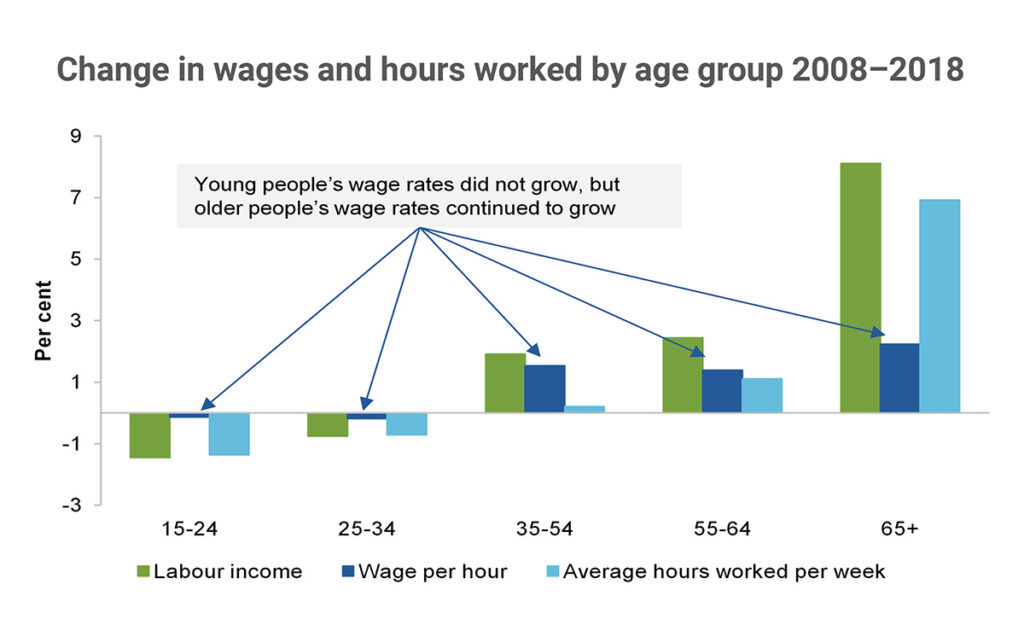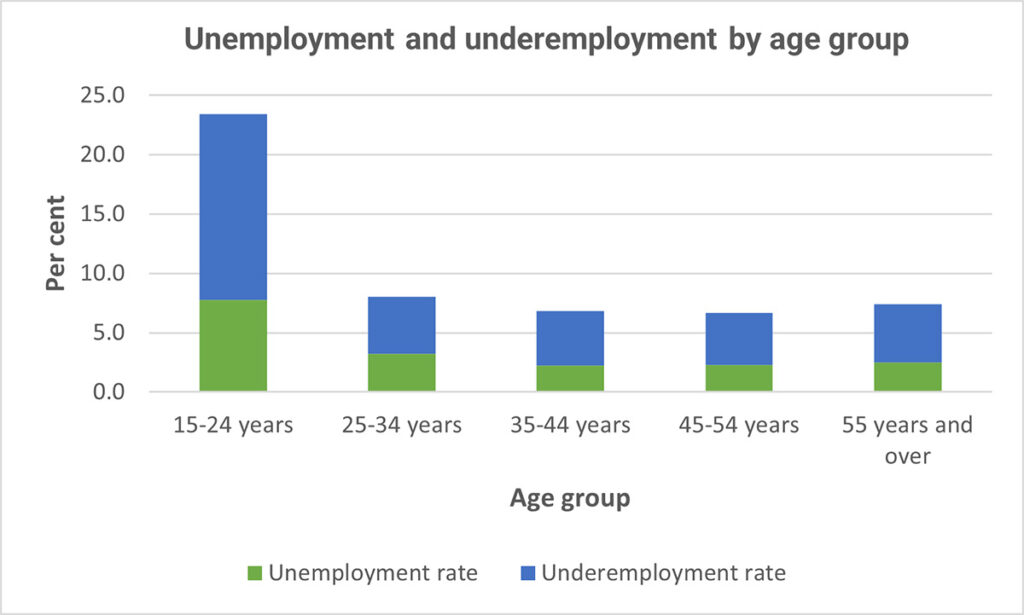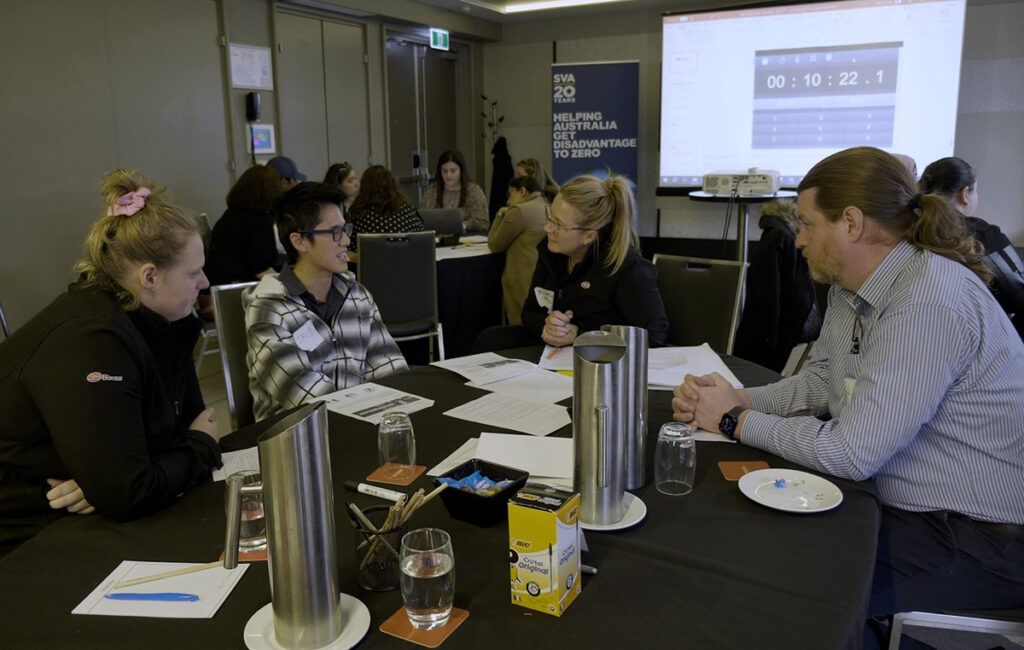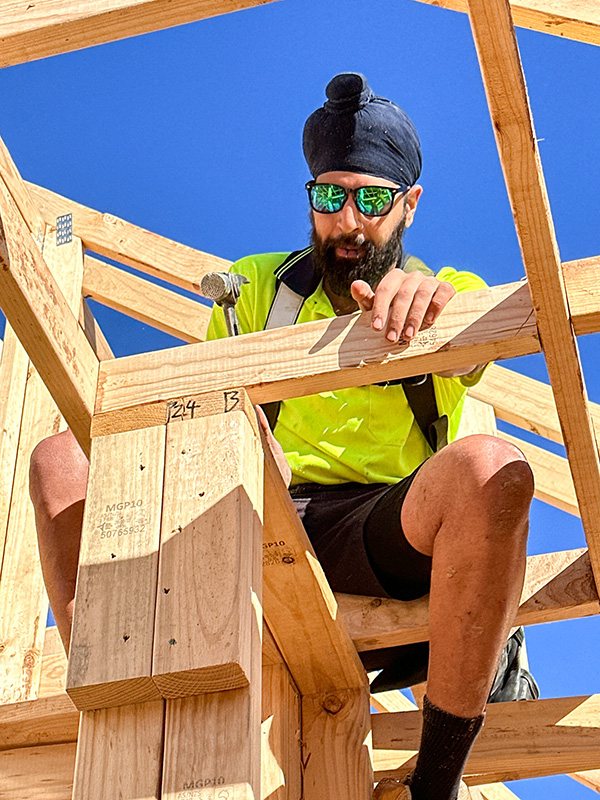
Rebuilding the career ladder
SVA’s Rebuilding the Career Ladder initiative focuses on improving opportunities for young people from less privileged backgrounds by promoting changes in employers’ hiring and employment practices.

- Despite very low levels of overall unemployment, nearly 1 in 4 young people aged 15-24 are either unemployed or underemployed
- Rebuilding the Career Ladder recognises that employers hold the key to improving job quality and rebuilding careers for young people. It includes practical support for employers through the ‘Employer Innovation Lab’ program, as well as strategies to address broader obstacles to employer action.
- The Employer Innovation Lab is a 12 month program which takes employers through a process of designing, implementing and assessing a small pilot within their organisation.
- Many of the first group of employers to participate in the Lab are moving from the initial pilot phase to embedding changes in their businesses as ‘business as usual’.
- Having now secured three years of funding from Macquarie Group Foundation (MGF) and the Paul Ramsay Foundation (PRF), SVA has developed a wider, five pillar strategy which addresses the obstacles to improving quality job outcomes for less privileged youth at a more systemic level.
In 2019 the Grattan Institute warned that ‘Today’s young Australians are in danger of being the first generation in memory to have lower living standards than their parents’ generation.’ According to the Productivity Commission, young people’s incomes have actually been declining relative to older workers, compounding intergenerational wealth inequalities and the disproportionate impact of housing costs on the young.
When it analysed the reasons for falling youth incomes, the Productivity Commission pointed to issues of job quality – a combination of the decline in the average number of hours worked (underemployment) and the fact that young people are entering the workforce in lower skilled jobs, and climbing the career ladder more slowly (see Figure 1).1
The groups hardest hit by these trends are young people from less privileged backgrounds or facing other forms of labour market disadvantage. At 24, young people born into low socio-economic status families are five times as likely to be out of work (and of education) than those born into high SES families.2

Despite very low levels of overall unemployment, nearly 1 in 4 young people aged 15-24 are either unemployed or underemployed (Figure 2).3 Employers are reporting skills shortages across occupations and industries, yet workplace training has been on the decline.4 The National Skills Commission (now Jobs and Skills Australia) recently reported that employers were more inclined to leave a job vacant than re-specify the job.5

SVA’s Rebuilding the Career Ladder initiative focuses on improving opportunities for young people from less privileged backgrounds by promoting changes in the hiring and employment practices of employers. It recognises that employers hold the key to improving job quality and rebuilding careers for young people. It includes practical support for employers through the cornerstone ‘Employer Innovation Lab’ program, as well as strategies to address broader obstacles to employer action.
Finding ways of engaging employers
SVA has had a long history of looking at ways of better engaging employers in addressing exclusion. In 2018, Simon Crabb, an Associate Director in its Employment Team, won a Victorian Government Innovation Fellowship to examine effective international approaches to working with employers. While in the US, he visited FSG’s Talent Rewire initiative, and identified its ‘Innovation Lab’ as a promising practice for Australian employers.
In 2021 support from the Citi Foundation and Macquarie Group Foundation enabled SVA to secure a license from FSG to adapt and deliver the model in Australia. Since 2022, 19 employers have participated in SVA’s Employer Innovation Labs in Western Sydney, while recruitment is underway for our next Lab in Melbourne starting in October 2023.
About the Employer Innovation Lab
The Employer Innovation Lab is a 12 month program which takes employers through a process of designing, implementing and assessing a small pilot within their organisation. Each Lab kicks off with a two day workshop structured so as to allow employers to identify changes in their practices that might provide better jobs for less privileged young people, and to design a project to trial these changes in practice. A key part of this process is bringing in the voices of young people who have, themselves, faced challenges in finding decent work. This occurs through focused interview research commissioned by SVA, and through bringing young people into the workshops to meet with employers and give feedback on their ideas. Following the workshop, SVA holds regular coaching calls with employers and works with them to identify good practice, identify success measures, and to connect them with community organisations to partner with on implementation.

An important feature of the Lab model is that it focuses on piloting practice changes in a small way rather than emphasising large numbers of job placements. The model seeks to achieve impact through testing and proving change at a small scale, then going on to embed and expand practice change across the organisation. Employers are encouraged to apply systems thinking to their pilot, so that it provides a foundation for sustainable, systemic change, for longer term impact.
SVA has engaged leading academics in the field to evaluate the Employer Lab initiative (Professor Angela Knox, University of Sydney and Associate Professor Jo Ingold Deakin). In their initial evaluation they reported that:
‘Overwhelmingly, the participants interviewed endorsed the Lab, emphasising that it challenged their preconceived ideas as well as their existing policies and practices with respect to recruitment and retention. In doing so, the Lab positively transformed their attitudes toward young people and created a catalyst to develop policies and practices capable of delivering more sustainable win-win outcomes along with the knowledge and support required to achieve those outcomes.’
Many of the first group of employers to participate in the Lab are moving from the initial pilot phase to embedding changes in their businesses as ‘business as usual’.
“… one of the most profound things I have achieved in my career…”
Consep case study
Consep is a medium-size engineering business in Wetherill Park (NSW). Its Managing Director, Grant Steward, recognised that they needed to rethink their hiring practices to address ongoing challenges in filling skilled jobs across the company. With SVA’s help, Consep piloted a ‘Young Starters program’ to bring young people, who were struggling to get decent work, into their business. Rather than advertise through their usual channels, Consep held an ‘open day’ for local young people, sourced through local youth employment agencies. They provided six months paid work placements, rotating through different parts of their business. From this group they have now employed five young people. Three have started boiler maker apprenticeships with the company, including one young woman. For the first time, Consep now has women in production and trades roles.
An unexpected benefit of the program has been increased engagement from staff across the company who have embraced the Young Starters program. Steward has described the program as ‘one of the most profound things I have achieved in my career,’ and is implementing the program in Consep’s Canadian operation.
The National Timber and Hardware Association case study
The National Timber and Hardware Association (NTHA) is an industry association. They came into the Lab conscious of the need to diversify its industry and to address low rates of apprentice retention/completion. Its pilot involved re-engineering their attraction and recruitment processes to ensure that they were accessible to a wider range of young people.
They re-worked their recruitment material and introduced a pre-interview site visit for young people. They shifted to a more conversational interview style. New tools were introduced to measure the demographic profile of apprentices and to check in on their employment experience.
They increased work support for apprentices and worked to shift host employers’ thinking about diversity. At the end of the pilot period, despite overall contraction in apprentice numbers, NTHA reported an increase in the diversity of its workforce – from 15% to 20%.6 Apprentice retention also improved.

Working towards wider impact
Through the Employer Innovation Lab, SVA is providing practical support to employers to create quality jobs for young people. But, in doing so, the wider obstacles to improving employment opportunities for less privileged youth have been brought into focus. Despite evidence of the powerful effect of socio-economic status on opportunities, very few employers have strategies to address exclusion of young people from poorer backgrounds. The impact of poor-quality jobs on young people is not widely known. And evidence of ‘what works’ or successful programmatic responses is limited.
Having now secured three years of base funding from Macquarie Group Foundation (MGF) and the Paul Ramsay Foundation (PRF), SVA has developed a wider, five pillar Rebuilding the Career Ladder strategy. This includes, but also builds on, the Employer Innovation Labs. The five pillars address the obstacles to improving quality job outcomes for less privileged youth at a more systemic level:
| Building understanding & commitment among employers | Ensuring young people’s voices are heard | Building an Australian evidence base of what works | Practical assistance to employers (e.g. through Employer Innovation Labs) | Identifying effective program responses |
The three year grant from PRF and MGF has enabled SVA to operate more strategically, and to commit to more Employer Innovation Labs. Our early work has also uncovered key areas that need greater action and investment:
Recently commissioned work conducted for SVA by Essential Media has revealed a lack of awareness amongst employers of these issues. Unlike the UK and the US, where employers and NFPs have collaborated to highlight social mobility challenges, this area is underdeveloped in Australia.
While the Lab has been designed for medium to large businesses, 41% of Australians work for smaller businesses. SVA is currently scoping design and delivery of a small business Lab, with a view to delivery in 2024.
[The] initiative is designed to bring attention to employer actions that can increase or limit economic mobility for young people born into less advantaged families.
The need to upskill supervisors and middle managers to better manage and support young people has emerged as a critical issue in our work with employers and discussions with young people. While there are examples of ad hoc responses to this issue, evidence of ‘what works’ is scarce.
Finally, our previous research into employer willingness to build careers for young people suggests that some employers will wait for more broadscale policy action before they change their practices. Policies that can promote greater employer action need further investigation and advocacy.
The Rebuilding the Career ladder initiative is designed to bring attention to employer actions that can increase or limit economic mobility for young people born into less advantaged families. Through Employer Innovation Labs, SVA delivers direct, practical support for employers who are willing to critically examine their employment practices. If your organisation is one of these, or if you know of others, please get in touch to secure your spot in one of our Labs.
Realising the broader ambition of the project will need more. SVA has been talking with others in our sector to identify a shared language, and shared agenda around improving quality job opportunities for young people. We would welcome discussions with potential funding, policy and campaign partners towards this goal.
SVA thanks the Paul Ramsay Foundation, Citi Foundation and Macquarie Group Foundation for their generous support of Rebuilding the Career Ladder.
- de Fontenay, C, Lampe B, Nugent J, and Jomini P, Climbing the jobs ladder slower: Young people in a weak labour market, Productivity Commission Staff Working Paper, 2020.
- Strawa, C, Supporting young people experiencing disadvantage to secure work, Australian Institute of Family Studies, Nov 2022.
- Australian Bureau of Statistics Cat 6202.0 Labour Force, Australia, June 2023.
- Buchanan J, Submission to Productivity Commission – Interim Report – National Agreement on Skills and Workforce Development, Aug 2020.
- National Skills Commission, 2022 Skills Priority List Key Findings Report, 2022.
- Diversity here is measured by the proportion of apprentices who are women, Indigenous, Culturally and Linguistically diverse, and/or people with disabilities.





